Nissan VR engine
The VR is a series of twin-turbo DOHC V6 automobile engines from Nissan with displacements varying from 3.0 to 3.8 L (2,997 to 3,799 cc). An evolution of the widely successful VQ series, it also draws on developments from the VRH, JGTC, and Nissan R390 GT1 Le Mans racing engines.
| Nissan VR engine | |
|---|---|
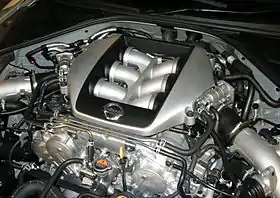 | |
| Overview | |
| Manufacturer | Nissan (Nissan Machinery) |
| Production | 2007–present |
| Layout | |
| Configuration | 60° V6 |
| Displacement | 3.0 L (2,997 cc) 3.8 L (3,799 cc) |
| Cylinder bore | 86 mm (3.39 in) 95.5 mm (3.76 in) |
| Piston stroke | 86 mm (3.39 in) 88.4 mm (3.48 in) |
| Block material | Aluminum |
| Head material | Aluminum |
| Valvetrain | DOHC, 4 valves x cyl. |
| Compression ratio | 9.0:1, 10.3:1 |
| Combustion | |
| Turbocharger | Twin-turbo |
| Fuel system | Multi-point (VR38DETT)/Direct injection (VR30DDTT) |
| Fuel type | Gasoline |
| Cooling system | Water-cooled |
| Dimensions | |
| Dry weight | 429.5 lb (194.8 kg) (VR30DDTT) 608 lb (276 kg) (VR38DETT) |
| Chronology | |
| Predecessor | Nissan VQ engine, RB26DETT |
DDTT series
VR30DDTT
Announced by Infiniti on December 15, 2015 the VR30DDTT[1] was first made available in the Infiniti Q50 sedan, followed by the Infiniti Q60 coupé a year later. Both platforms come in a 300 and 400 hp (224 and 298 kW) version.[2] It is on the Ward's 10 Best Engines list for 2017 and 2018.
Features:[3]
- Aluminium block with arc sprayed mirror coating to cylinder bores
- Aluminium cylinder head
- Lightweight resin intake and lower oil pan
- Compact twin direct-mount turbos with integrated exhaust manifold and electronic wastegate actuator
- Twin water-to-air charge coolers with one 300 hp (224 kW)/two 400 hp (298 kW) water pumps
- Electronically controlled variable displacement oil pump
- Intake: electronic Variable valve timing Control (VTC)
- Exhaust: hydraulic continuously variable VTC
- Fuel system: direct injection

Applications:
| Years | Model | Power output |
|---|---|---|
| 2016-present | Infiniti Q50 | 300–400 hp (224–298 kW) |
| 2017-present | Infiniti Q60 | 300–400 hp (224–298 kW) |
| 2019-present | Nissan Skyline | 300–400 hp (224–298 kW) |
Production
Production of the VR30DDTT engine began in 2016 at the powertrain plant in Iwaki, Fukushima, Japan.[4][5][6]
DETT series
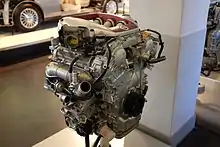
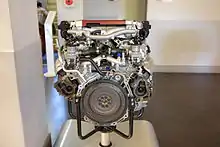
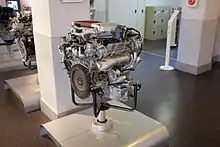
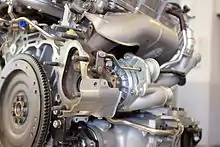
VR38DETT
Designated the VR38DETT by Nissan, the engine is currently used in the 2007–present Nissan GT-R[7] and the limited production Nissan Juke-R.
The VR38DETT features 24 valves controlled by dual overhead camshafts (2 per cylinder head) with variable valve timing on the intake only. The block is cast aluminium with 0.15 mm (0.0059 in) plasma-sprayed cylinder liner bores. This coating provides a hard protective layer for the piston rings to slide on as the piston moves up and down during its power cycle. The turbine housings for the two IHI turbochargers are integrated into the exhaust manifolds to decrease weight and bolster vehicle balance. The engine also features a pressurized lubrication system controlled thermostatically. The VR38DETT is equipped with a feedback control system that changes air fuel ratio depending on the engine load which has a significant effect on reducing the fuel consumption.[8]
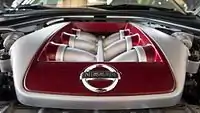
Fully equipped with the first set of catalytic converters, turbos, all of the engine driven accessories, front differential assembly, and turbo outlet pipes, the engine weighs 608 lb (276 kg).[9]
Other pertinent features of the VR38DETT include:
- Continuously variable valve timing control system (CVTCS) on intake valves
- Aluminum cylinder block with high-endurance/low-friction plasma-sprayed bores
- Iridium-tipped spark plugs
- Electronic drive-by-wire throttle
- Multi port fuel injection
- Pressurized lubrication system with thermostatically controlled cooling and magnesium oil sump
- Fully symmetrical dual intake and low back-pressure exhaust system
- Secondary air intake system to rapidly heat catalysts to peak cleaning efficiency
- 50 State LEV2/ULEV
Applications:
| Years | Model | Power output |
|---|---|---|
| 2008–2011 | Nissan GT-R CBA-R35 | 480–485 hp (358–362 kW) |
| 2012–present | Nissan GT-R DBA-R35 | 530–565 hp (395–421 kW) |
| 2014–present | Nissan GT-R Nismo | 600 hp (447 kW) |
| 2020 | Nissan GT-R50 by Italdesign | 710 hp (529 kW) |
| 2012–present | Nissan Juke-R (limited production run) | |
| 2014 | Infiniti Q50 Eau Rouge Prototype (Concept car) | 560 hp (418 kW) |
| Racing: | ||
| 2012–present | Nissan GT-R Nismo GT3 | 500 hp (373 kW) |
| 2014–present | Renault R.S. 01 | 500 hp (373 kW)+[10] |
| 2017–present | Nissan Onroak DPi (Ligier JS P217) | |
VR38DETT NISMO Engine Tuning Menu Concept (2016)
It is a version of VR38DETT engine used in Nissan GT-R, with GT3-spec camshaft, connecting rod and connecting rod bolt, intercooler, intercooler piping, turbocharger, NISMO 1st and 2nd catalyzers, titanium muffler.
Engine reference
| Engine code | Vehicle | Year | Displacement | Bore x stroke | Weight | C.R. | Max. power | Max. torque | Features |
|---|---|---|---|---|---|---|---|---|---|
| VR38DETT | Nissan GT-R | 2007–current | 3,799 cc (3.8 L; 231.8 cu in) | 95.5 mm × 88.4 mm (3.76 in × 3.48 in) | approx.608 lb (276 kg) | 9.0:1 | approx. 480–565 hp (358–421 kW) @ 6400 rpm 600 hp (447 kW) @ 6800 rpm (NISMO) 710 hp (529 kW) (GT-R50) | 588–652 N⋅m (434–481 lbf⋅ft) @ 3200-6000 rpm 780 N⋅m (575 lbf⋅ft) (GT-R50) | DOHC per bank Variable inlet cam phasing Twin Turbo |
| VR30DDTT | Infiniti Q50/Nissan Skyline | 2016–current | 2,997 cc (3.0 L; 182.9 cu in) | 86 mm × 86 mm (3.39 in × 3.39 in) | approx.429.5 lb (194.8 kg) | 10.3:1 | approx. 400 hp (298 kW) @ 6400 rpm (High Output) 300 hp (224 kW) @ 6400 rpm (Standard Output) | 475 N⋅m (350 lbf⋅ft) @ 1600-5200 rpm (High output) 400 N⋅m (295 lbf⋅ft) @ 1600-5200 rpm (standard output) | High pressure multi-split direct injection DOHC per bank Variable inlet and outlet cam phasing Twin Turbo |
References
- 2016 Infiniti Q50 3.0t spec sheet
- "Infiniti announces new 3.0-liter V6 twin-turbo engine – the most advanced V6 ever offered by Infiniti". Nissan Online Newsroom. Retrieved 2015-12-16.
- "Infiniti VR 3.0-liter V6 Twin-Turbo Specifications". Infiniti.
- "3.0-liter V6 twin-turbo engine: the most advanced V6 for Infiniti".
- "インフィニティモデルに新型3.0リッターV6ツインターボエンジンを搭載".
- "Production of Infiniti's 'VR30' twin turbo 3.0-liter V6 engine begins in Japan".
- "日産:NISSAN GT-R [ GT-R ] スポーツ&スペシャリティ/SUV Webカタログ ホーム". .nissan.co.jp. 2007-10-24. Archived from the original on 2011-09-28. Retrieved 2010-03-26.
- JDM Spec Engines - Nissan VR38DETT Engine
- "VR38DETT engine weight | 2009 Nissan GT-R". 2009gtr.com. 2008-02-28. Retrieved 2010-03-26.
- 「東京オートサロン2016」出展概要を発表
- مجلة أفكار العربية : Nissan GT-R Nismo VR38DETT Engine Tuning Menu Concept - Tokyo Auto Salon 2016
- "Takumi: The Master Craftsmen behind Each Nissan GT-R". Nissan. 25 July 2013. Retrieved 19 May 2020.
- "Nissan's Legendary Takumi: Four Master Craftsmen Who Hand-Build Every Nissan GT-R Engine". 16 September 2013. Retrieved 19 May 2020.
- "Nissan". Ultimate Factories. Season 6. Episode 12. 15 November 2012.
- Dalle Carbonare, Dino (28 July 2009). "Car Builder>> How The Nissan Gt-r Is Built". Speedhunters. Archived from the original on 12 August 2018. Retrieved 19 May 2020.
- Perry, Joanne (14 August 2017). "Nissan Tochigi's human touch". Automotive Manufacturing Solutions. Retrieved 19 May 2020.
